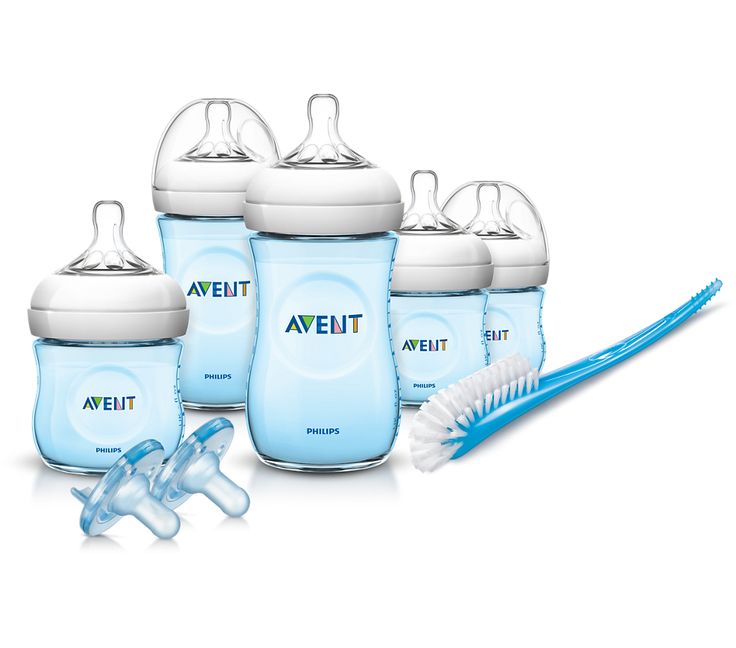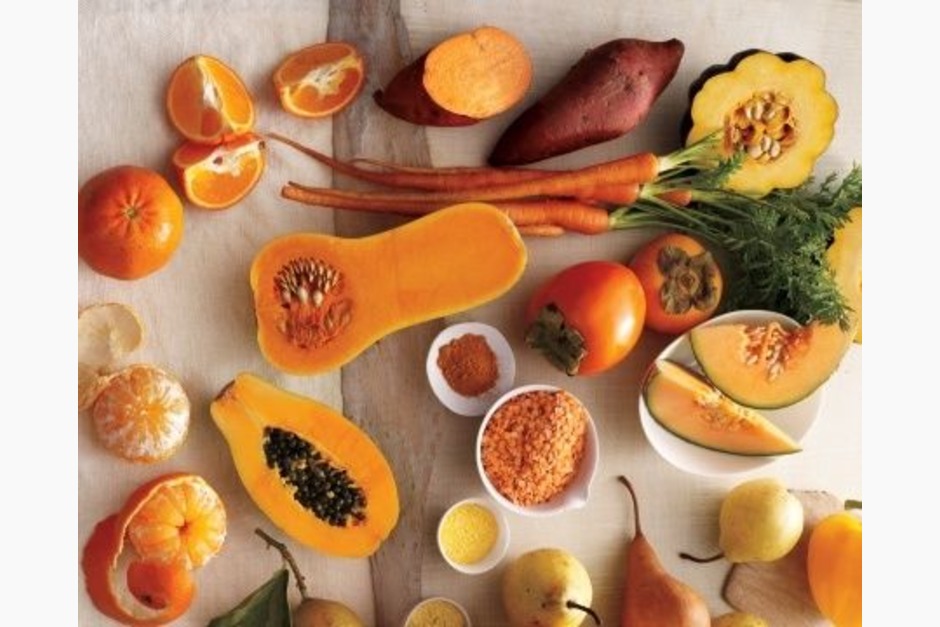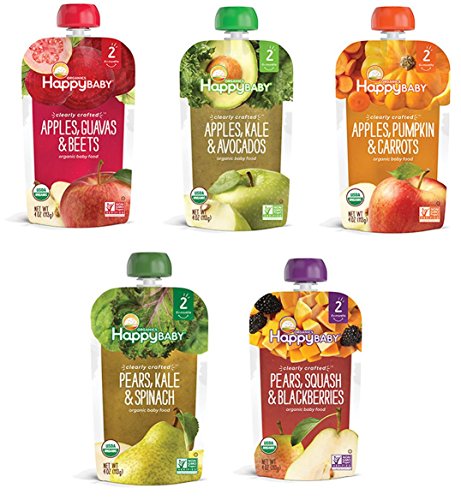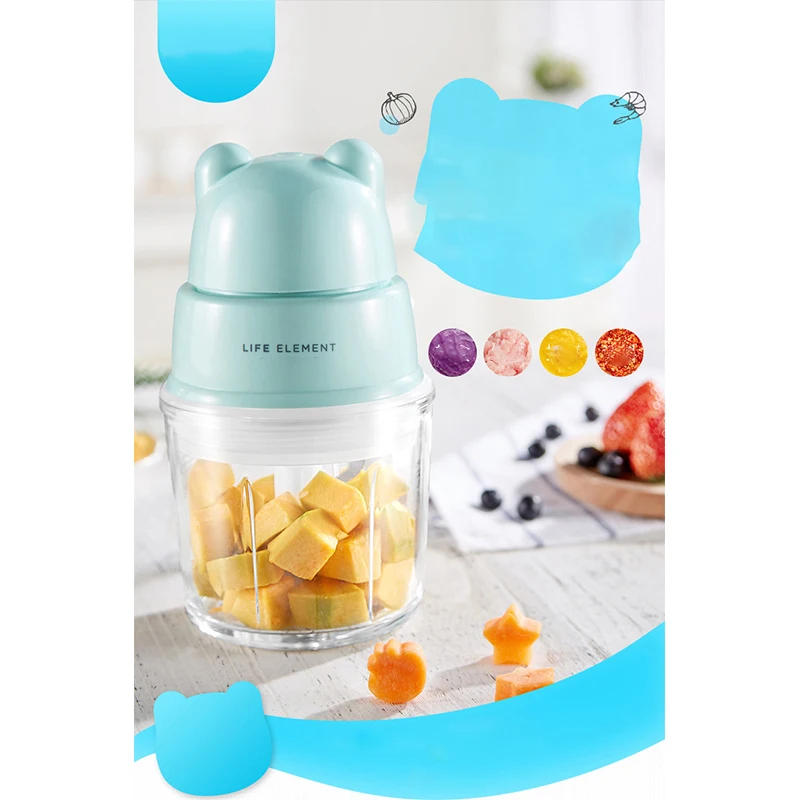Peanut baby food
When Can Baby Have Peanut Butter (and 3 Best Ways to Offer It)
When can baby have peanut butter? That’s such a common question among us parents, and it’s normal to be worried about allergic reactions. Thankfully, there are easy ways to offer peanut butter to a baby and simple tips to keep in mind when introducing it for the first time.
When can baby have peanut butter?
The American Academy of Pediatrics recommends that potentially allergenic foods are introduced early on when starting solids at 6 months. This advice has changed recently and family members may not realize that it’s not advised to wait until a child turns 1 any longer.
In fact, waiting can actually increase the likelihood of a reaction.
How to Introduce Peanut Butter to a Baby Step-by Step
According to the National Institute of Allergy and Infectious Diseases, start by considering which group your child falls into:
- They have severe eczema and/or an egg allergy.
In this case, talk with your doctors about peanut allergy testing and testing a peanut product for the first time in their office. Babies in this group are advised to get their first peanut product between 4-6 months.
- They have mild or moderate eczema. Talk to your doctor, but it is likely safe to introduce peanut products around the 6 month mark.
- They have no signs of eczema or food allergies. Offer peanut products soon after starting solids as you introduce all sorts of other foods.
TIP: Talk to your pediatrician about any concerns you have, at any time. If you are at all worried, you can always introduce a peanut product in their office with their supervision to alleviate your stress. Just talk to them about your plan ahead of time.
How soon would peanut allergy symptoms appear?
Typically, they appear soon after introducing the food. Symptoms of a peanut allergy may include anaphylaxis (which is the most severe), but also things including vomiting, indigestion, diarrhea, wheezing, repetitive coughing, tightness in the throat, hives, swelling in the mouth, and more.
Diagnosing any food allergy can be complicated, so your best bet is to see a pediatric allergist.
TIP: The good news is that research has shown up to 20 percent of individuals with a peanut allergy eventually outgrow it.
Best Peanut Butter for Babies
Look for a peanut butter without added sugar and opt for creamy to ensure that the texture is smooth for baby. I like Smucker’s Natural Peanut Butter, Whole Foods 365 Store Brand, and Teddies.
There are lot of other options available, so just check the ingredients and look for one without added cane sugar or honey.
How to Avoid Choking With Peanut Products
The simplest way to avoid choking is to never offer actual whole peanuts. You should also avoid chunky peanut butter which will be difficult (and potentially dangerous) for a baby and avoid spoonfuls of straight peanut butter which can get stuck in their mouths.
See below for safe peanut options for baby.
What are the best ways to introduce and serve peanut butter to babies?
I have three favorite ways that I will outline below.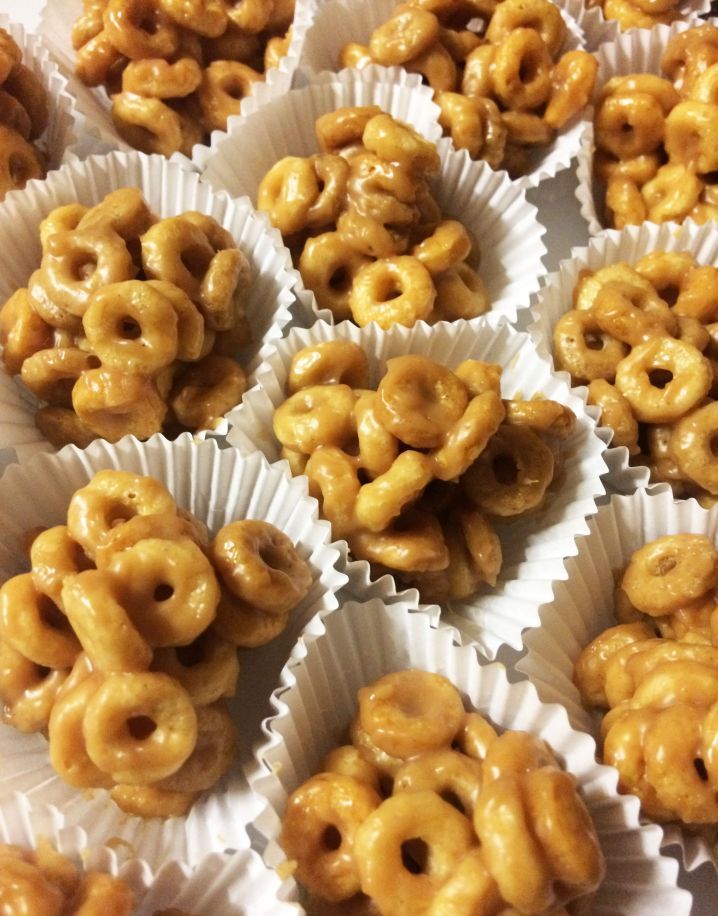 They include:
They include:
- Peanut Butter Toast
- Peanut Butter Puffs
- Peanut Butter Puree
TIP: I recently saw a tip about grinding nuts into a powder to mix into other foods like oatmeal, which is a great option too. For the first time you offer it, it may make sense to limit the other foods in the same meal so you can be sure to be able to easily isolate the cause if there’s a reaction.
Peanut Butter Toast for Baby
A simple way to offer peanut butter to baby is to spread a very thin layer onto a piece of lightly toasted bread. This is a classic baby led weaning approach where you cut the toast into a piece that’s at least as big as your finger so it’s way too big for the baby to put the entire thing into their mouth.
This is easy for a baby, even one as young as 6 months, to pick up and suck on. (This also works really well with mashed hard cooked egg yolk!)
TIP: Do be sure to lightly toast the bread to reduce the chances that a piece of soft bread will get stuck onto the roof of their mouth.
Peanut Butter Puffs
Another easy way to offer peanut butter to a baby or toddler is to use store-bought peanut butter puffs. The most commonly known one is called Bamba Puffs and Puffworks Baby also makes one. You can find them at Trader Joe’s and on Amazon. They are my favorite because they are big enough for a baby to suck on without putting the entire thing into their mouth.
Peanut Puffs from Mission Mighty Me are a nice options once babies develop their pincer grasp around 9 months.
TIP: The great thing about these is that they dissolve easily in baby’s mouth, are easy to hold, and are a healthy snack food you can continue serving through toddlerhood.
Peanut Butter Puree for Baby
My very favorite way to introduce peanut butter for the first time is to make it into a fluffy puree. It’s so easy, it’s good, and it’s very nutritious with health fats and protein. It’s a perfect no-cook baby food to make at home.
Ingredients You Need for Peanut Butter Puree
To make this puree, you just need natural creamy peanut butter and water. The water helps to fluff up the peanut butter making it into a yogurt-like consistency.
The water helps to fluff up the peanut butter making it into a yogurt-like consistency.
It’s smooth, flavorful, and can be stored for later too.
How to Make Peanut Butter Puree Step-by-Step
Here’s a look at how to make a simple peanut butter puree for a baby.
- Add peanut butter and water to a bowl.
- Start stirring together.
- Keep stirring together as the water begins to look cloudy.
- Keep stirring together until the mixture is a uniform texture and color.
TIP: Room temperature peanut butter and/or warmish water make this come together a little more easily than cold peanut butter.
Best Tips for Peanut Butter and Baby
- Store any peanut butter puree leftovers in an airtight container in the fridge for up to 5 days.
- Keep stirring if the mixture looks separated. It may take a full minute or more of stirring until the mixture comes together.
- If it seems thick or sticky, thin it out more with additional water.
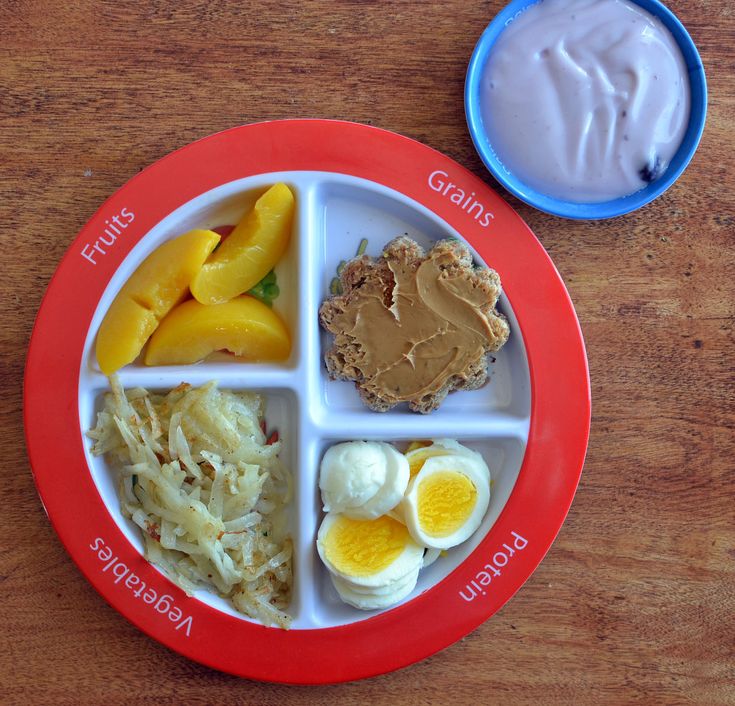
- Choose creamy natural peanut butter without added sugar.
- Offer a small amount on a spoon or spread a thin layer onto a 1-2 finger-size piece of toast.
- Stop feeding baby when they turn their head away and close their mouth. (The serving size below is just a ballpark guess.)
- Consider a peanut puff like the ones from Puffworks Baby.
- If baby has or had eczema or other food allergies, check with your pediatrician for guidance on introducing food allergens.
Related Recipes
I’d love to hear your feedback on this, so please comment below to share!
Prep Time 5 minutes
Cook Time 0 minutes
Total Time 5 minutes
Author Amy Palanjian
Cuisine American
Course Baby Food
Calories 24kcal
Servings 4 -6
- ▢ 1 tablespoon creamy natural peanut butter (without added sugar if possible)
- ▢ 2-3 tablespoons water
Add the peanut butter and 2 tablespoons water to a bowl.

Stir until the mixture starts to come together and the color and consistency are uniformly light and somewhat fluffy. This will take a little bit of time so keep going if and when the peanut butter separates.
Add water as needed to make a fluffy puree consistency.
Offer on a spoon to baby in small amounts or spread onto a 1-2 finger-size piece of toast.
Peanut Butter
Mixing Bowl
Storage Containers
- Store any leftovers in an airtight container in the fridge for up to 5 days.
- Keep stirring if the mixture looks separated. It may take a full minute or more of stirring until the mixture comes together.
- If it seems thick or sticky, thin it out more with additional water.
- Choose creamy natural peanut butter without added sugar.
- Offer a small amount on a spoon or spread a thin layer onto a 1-2 finger-size piece of toast.
- Stop feeding baby when they turn their head away and close their mouth.
 (The serving size below is just a ballpark guess.)
(The serving size below is just a ballpark guess.)
Calories: 24kcal, Carbohydrates: 1g, Protein: 1g, Fat: 2g, Saturated Fat: 1g, Polyunsaturated Fat: 1g, Monounsaturated Fat: 1g, Sodium: 19mg, Potassium: 26mg, Fiber: 1g, Sugar: 1g, Calcium: 2mg, Iron: 1mg
Tried this recipe?Rate in the comments and tag @yummytoddlerfood on IG!
This post was first published August 2020.
Peanut / Peanut Butter for Babies
When can babies eat peanuts?
Peanut may be introduced as soon as baby is ready to start solids, which is generally around 6 months of age. Whole peanuts, chopped peanuts, and peanut butter are choking hazards for babies and children, so check out how to prepare them in safe ways.
If you are feeling terrified to introduce nuts to your baby, watch our peanut and allergen videos in our virtual course, which were created by our award-winning allergist MD and our founder, who is an allergy mom.
Warning
Peanuts are a common choking hazard, so keep reading to learn how to serve them safely.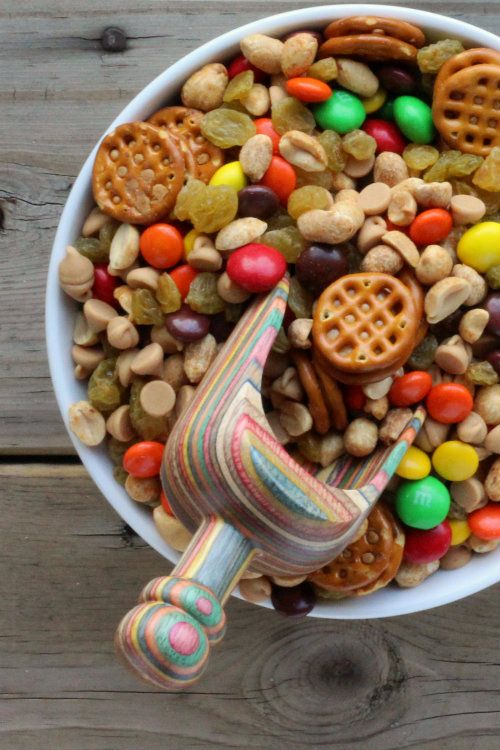
Background and origins of peanuts
Real talk: peanut makes people nervous. And for good reason: peanut is one of the most common food allergens in children.1 However, there is evidence that introducing peanut in a baby’s diet early and frequently may significantly reduce the risk of developing a peanut allergy.2 Conversely, delaying introduction of peanut may increase the likelihood of a peanut allergy later on in life in infants at high risk of peanut allergy.3
Classified as a major allergen by food regulators, peanut is not actually a nut, but rather the edible seed of a legume plant that grows underground. Peanut originated in South America, where Indigenous people cultivated the groundnut for nourishment and ceremonial purposes. European colonizers brought peanuts with them around the globe. Today the legume is the world’s most consumed “nut” and an important staple food in Africa, Asia, and North America.
Are peanuts healthy for babies?
Yes. Peanuts pack a powerful nutrition punch. They contain plenty of protein, fat, and fiber to nourish the body and antioxidants that may support heart health.4 6 7 Peanuts are also rich in essential nutrients that work together to grow the brain (folate, vitamins B6 and E, and zinc) and energize the body (copper, vitamin B3, and magnesium).8 9 10 Just be sure to purchase unsalted peanuts as many peanuts contain lots of sodium, which in excess is not healthy for babies (or adults).
You may have heard debate over the health implications of lectins, oxalates, phytates in peanuts.11 12 13 Fear not—these plant compounds are mostly harmless when consumed in moderation as part of a balanced diet, plus they can be reduced by roasting peanuts—a standard method of processing this healthy legume for consumers.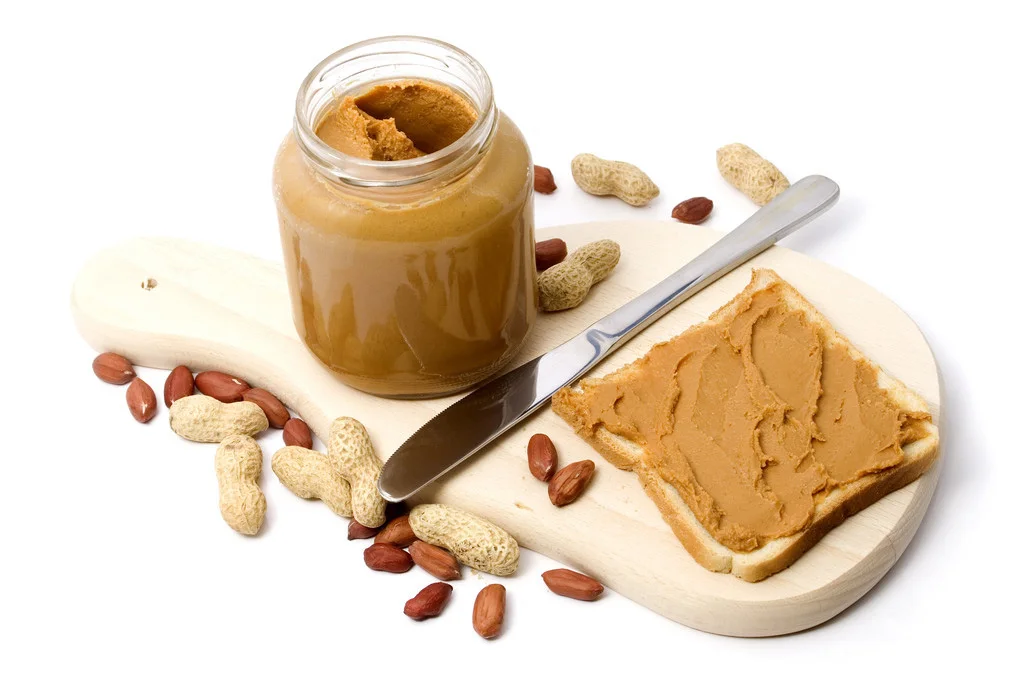 14
14
Lastly, but certainly not least, peanut flour is becoming an increasingly popular food item. Peanut flour is made from ground peanuts that have had the fat content removed, hence why it is also called defatted peanut flour or powder.15 While it is lacking in fat, it still contains significant amounts of fiber, protein, and micronutrients such as zinc, vitamin B6, and folate.16
★Tip: Peanuts and peanut butter are susceptible to fungi and mold, but there are ways to minimize the risk: keep open jars of peanut butter in the fridge, purchase unsalted roasted peanuts, or roast unsalted raw peanuts at home after purchase.17
Is peanut butter healthy for babies?
Yes—as long as it is free of added sodium and sugar. When shopping for peanut butter for babies, buy unsalted, smooth peanut butter with no added sugar, sweeteners, flavorings, hydrogenated oil, or other preservatives.
★Tip: Watch out for imposters! Some peanut butter contains hydrogenated oils and sweeteners like chocolate, which are not appropriate for babies.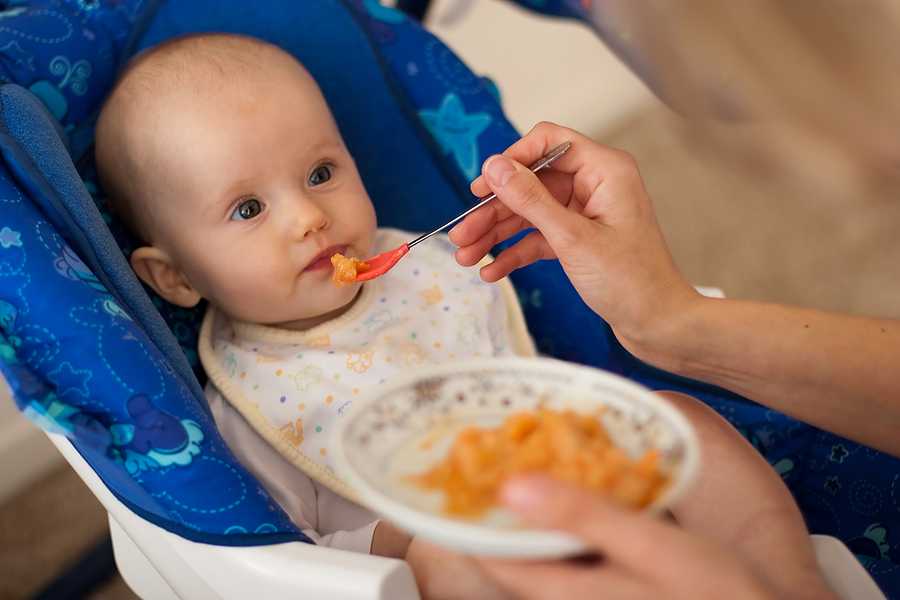 When possible, opt for jars of smooth peanut butter that are marked “natural”, “unsalted”, and “no added sugar”.
When possible, opt for jars of smooth peanut butter that are marked “natural”, “unsalted”, and “no added sugar”.
Is peanut oil okay for babies?
Yes. Both refined and unrefined peanut oil are fine as cooking oils. Peanut oil is either ultra-processed at high heats to remove the color and taste (refined peanut oil) or cold-pressed to retain flavor and nutrition (unrefined peanut oil). Both types add healthy fats to a baby’s diet, however, you may want to reserve unrefined peanut oil for a splash of flavor in a dish and choose refined peanut oil for high heat cooking as it has a higher smoke point and is less likely to turn rancid while cooking. The smoke point of refined peanut oil is 450 degrees Fahrenheit / 232 degrees Celsius.
Is peanut flour healthy for babies?
Yes, though it is best added to other foods. Peanut flour is made by grinding and stripping peanuts of their healthy fats, which is why it is sometimes marketed as “defatted” peanut flour or powder.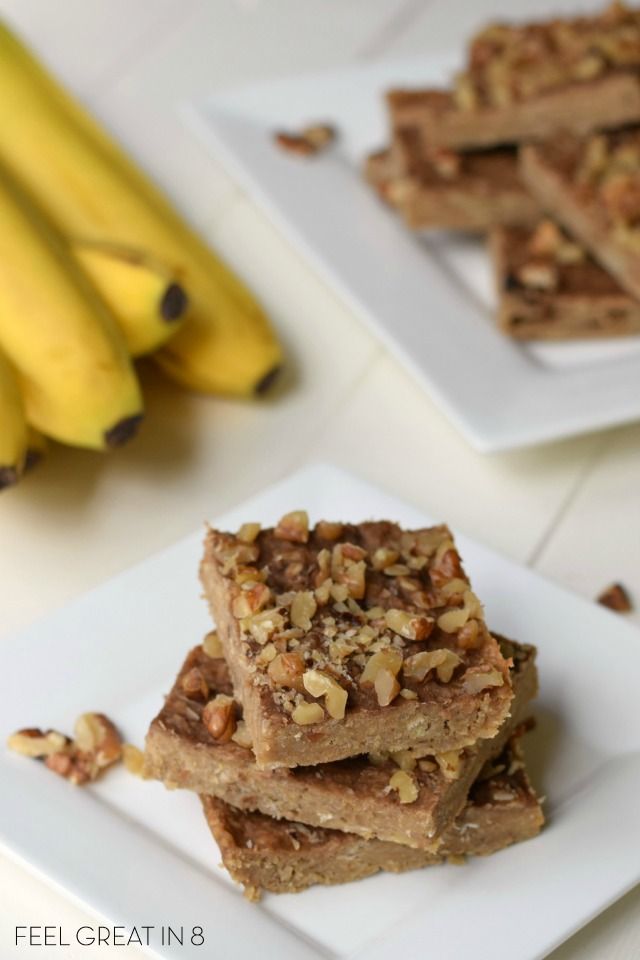 18 While peanut flour lacks fat, it still contains significant amounts of fiber, protein, and micronutrients such as zinc, vitamin B6, and folate.
18 While peanut flour lacks fat, it still contains significant amounts of fiber, protein, and micronutrients such as zinc, vitamin B6, and folate.
Are peanuts a common choking hazard for babies?
Yes. All nuts, nut pieces, and nut butters are choking hazards for babies and children.19 To reduce the risk, thin peanut butter out with water, breast milk, formula, or purées like applesauce and finely grind peanuts to sprinkle on other food. As always, be sure to create a safe eating environment, stay within arm’s reach of a baby during meals, and check out our age-appropriate serving suggestions.
For more information, visit our section on gagging and choking and familiarize yourself with common choking hazards.
Are peanuts a common allergen?
Yes. Peanut allergies in children are on the rise, with a greater risk among babies with severe eczema or an existing egg allergy.20 If you believe a baby may have a peanut allergy or if a baby has severe eczema, consult a pediatric allergist before introducing peanuts.
Unfortunately, peanut allergies tend to be lifelong. Only about 20% of children outgrow a peanut allergy.21 Furthermore, kids who are allergic to peanuts have a greater chance (between 25 and 40%) of being allergic to one or more tree nuts.22 Interestingly, for those with peanut allergies, highly refined peanut oils are typically tolerated because the allergenic peanut proteins are removed during processing. However, unrefined peanut oil still poses a risk of allergy due to retained proteins within the oil.23
A groundbreaking study demonstrated that the early introduction of peanuts could significantly reduce the risk of developing a peanut allergy later.24 Following the study, the U.S. National Institute of Allergy and Infectious Diseases now recommends that peanuts be introduced before a baby’s first birthday while considering any risk factors.25
As with all food allergens, it’s best to start small. Serve a scant amount (such as a pinch of ground peanut or 1/8 of a teaspoon of smooth peanut butter) during the first few meals and watch closely as reactions don’t always occur at first. If there is no adverse reaction after several meals, gradually increase the quantity of the serving over next couple days.
If there is no adverse reaction after several meals, gradually increase the quantity of the serving over next couple days.
Recommended Guide: Introducing Allergens to Babies
How do you prepare peanuts for babies with baby-led weaning?
Every baby develops on their own timeline, and the suggestions on how to cut or prepare particular foods are generalizations for a broad audience. Your child is an individual and may have needs or considerations beyond generally accepted practices. In determining the recommendations for size and shape of foods, we use the best available scientific information regarding gross, fine, and oral motor development to minimize choking risk. The preparation suggestions we offer are for informational purposes only and are not a substitute for child-specific, one-on-one advice from your pediatric medical or health professional or provider. It is impossible to fully eliminate all risk of a baby or child choking on any liquid, puree, or food.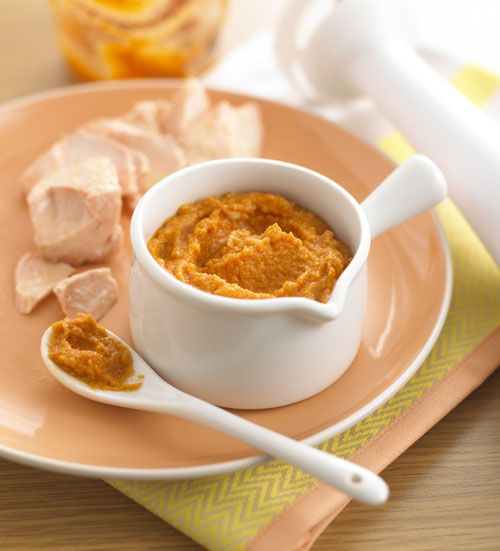 We advise you to follow all safety protocols we suggest to create a safe eating environment and to make educated choices for your child regarding their specific needs. Never disregard professional medical advice or delay in seeking it because of something you have read or seen here.
We advise you to follow all safety protocols we suggest to create a safe eating environment and to make educated choices for your child regarding their specific needs. Never disregard professional medical advice or delay in seeking it because of something you have read or seen here.
4 to 6 months old: Babies in this age range are not usually developmentally ready to feed themselves, so peanut is generally only recommended for introduction between 4 to 6 months of age if a doctor or allergist determines that the early introduction of the allergen is desirable (due to pre-existing risk factors for the development of peanut allergy such as severe eczema, egg allergy, or both).
To introduce peanut between 4 and 6 months of age you can thin the prescribed amount of smooth, unsalted peanut butter with hot water (let cool before serving) and offer the thinned peanut butter to your baby from your fingertip or from a pre-loaded spoon or use peanut flour or powdered peanut butter and combine equal parts of those with equal parts fruit or vegetable puree. Note: Starting solids early can be associated with unhealthy weight gain (both in infancy and early childhood).26 Therefore, our strong opinion is that it’s best to hold off on purées and simply introduce peanut as a thinned peanut butter from your fingertip.
Note: Starting solids early can be associated with unhealthy weight gain (both in infancy and early childhood).26 Therefore, our strong opinion is that it’s best to hold off on purées and simply introduce peanut as a thinned peanut butter from your fingertip.
Once the food is at the desired consistency and temperature, offer a small taste of the mixture (the tip of a teaspoon, for example). Wait 10 minutes, and if there are no signs of an allergic reaction, continue gradually feeding the remaining serving of the peanut-containing food at your baby’s natural feeding pace. Don’t worry if baby doesn’t finish the whole thing. Once baby is done eating, observe for another 30 minutes to ensure there are no signs of an allergic reaction. If a reaction does occur, stop feeding and immediately contact your healthcare provider or if the reaction is severe, emergency services. Read more about Symptoms of Allergic Reactions. If baby is able to tolerate the introduction of peanut into the diet, continue offering peanut at least twice a week. Studies show that sustained inclusion of peanut in the diet is key to its protective benefit against the development of peanut allergy.27
Studies show that sustained inclusion of peanut in the diet is key to its protective benefit against the development of peanut allergy.27
6 to 9 months old: Thin unsalted, smooth peanut butter out with water, breast milk, formula or purées like applesauce and either serve on its own for finger painting or mix into other foods like yogurt (if dairy has been introduced) or other scoopable foods. Alternatively you can grind unsalted raw or roasted peanuts to a fine consistency, then sprinkle a pinch on top of soft, scoopable foods like mashed fruits and vegetables, warm cereal, or yogurt. You can also roll slippery fruits like avocado, banana, or mango in ground peanut to add grip.
9 to 12 months old: Continue to mix unsalted, smooth peanut butter into soft, scoopable foods, roll slippery foods in finely ground peanuts to add grip, and use peanut oil for cooking vegetables, grains, and other whole foods.
12 to 24 months old: At this age you spread unsalted, smooth peanut butter on toast, pancakes, bread and bagels and no longer need to thin it with water or other liquids.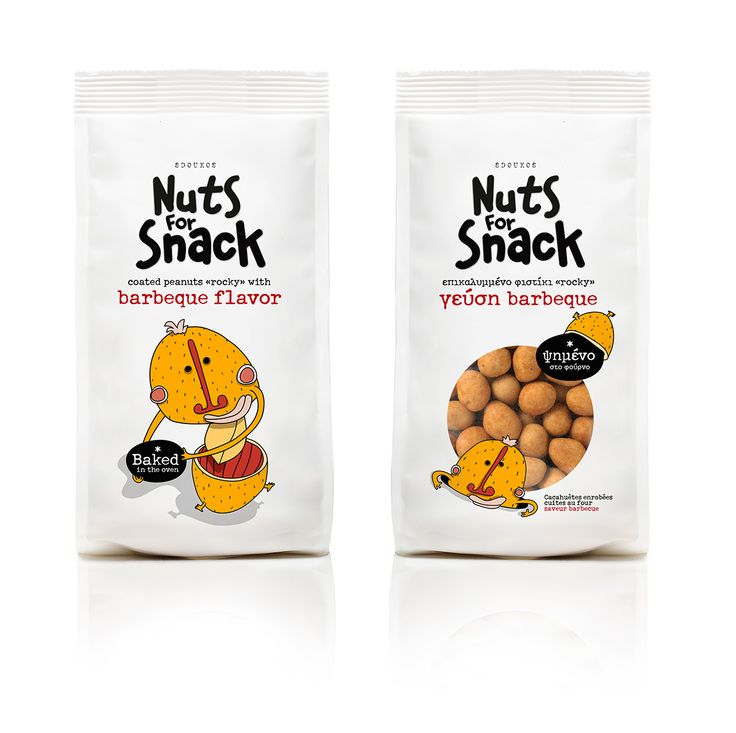 Avoid large globs of peanut butter and continue to finely grind whole peanuts.
Avoid large globs of peanut butter and continue to finely grind whole peanuts.
24 months old and up: After a toddler’s second birthday, they may be ready for whole peanuts if the child has developed advanced chewing and swallowing skills. Approach this step with great care and consideration: whole peanuts are among the top causes of non-fatal and fatal food-related choking incidents among children younger than age 3 in North America.28 To reduce the risk, start by splitting the peanuts in half (the halves easily slide apart with some pressure from your fingers) and make sure the child is in a safe eating environment. Start with one piece at a time. Demonstrate placing the peanut on your own molars and chew in a very exaggerated fashion. Explain to the child how much noise your teeth make breaking down the peanut. Coach your child to do the same. You can count out loud how many crunches your child can make on a peanut, ensuring thorough mastication.
For more information on how to cut food for babies, visit our page on Food Sizes & Shapes.
Recipe: Peanut Butter-Apple “Paint”
Yield: ½ cup paint
Time: 5 minutes
Age: 6 months+
Ingredients
- 1 teaspoon smooth peanut butter (no added salt or sugar)
- ½ cup no sugar added applesauce
- 1 ripe banana
- 1 teaspoon ground peanut (unsalted, raw or roasted)
Directions
- Whisk the peanut butter and applesauce until smooth—like paint!—in a wide enough bowl for baby’s hands to reach inside.
- Cut the banana in half crosswise. Peel one half and cut into spears. One quick way to do this: poke your index finger into the center of the cut side and push. The pressure naturally splits the fruit into spears.
- Roll the banana spears in the ground peanut. Store the other half of banana in the fridge for a future meal—or snack on it as baby eats!
- Serve: Place the banana spears and bowl of peanut butter “paint” in front of baby. Let baby self-feed by trying to scoop the banana spears and paint.
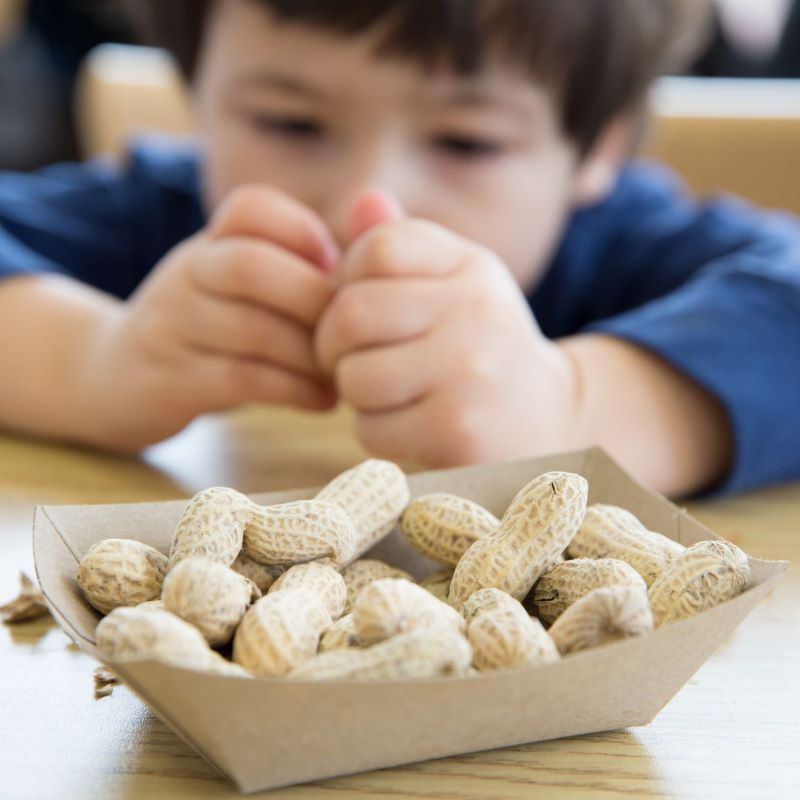 Show baby how to dip the spears (or little fingers!) in the bowl and paint on the surface in front of them.
Show baby how to dip the spears (or little fingers!) in the bowl and paint on the surface in front of them.
This recipe contains a common allergen: peanut. Only serve to your child after this allergen has been safely introduced.
Flavor Pairings
Peanut’s rich, nutty flavor tastes delicious with so many kinds of foods! Its earthiness balances the sweet and tart flavor of fruits like apple, banana, mango, papaya, pineapple, plantain, and strawberry, and plays up the brightness in green veggies like bell pepper, bok choy, cabbage, celery, collard greens, green bean, and spinach. A sprinkle of ground peanut can add extra richness to fellow protein-packed foods like beef, bison, chicken, and lamb and sweet seafoods like salmon, shrimp, tilapia, or trout. You can also top grains and noodles like amaranth, couscous, egg noodles, quinoa, pasta, rice, or soba with ground peanut—or stir ground peanut or peanut butter into mashed root vegetables and legumes like black beans, black-eyed peas, pumpkin, squash, or sweet potato.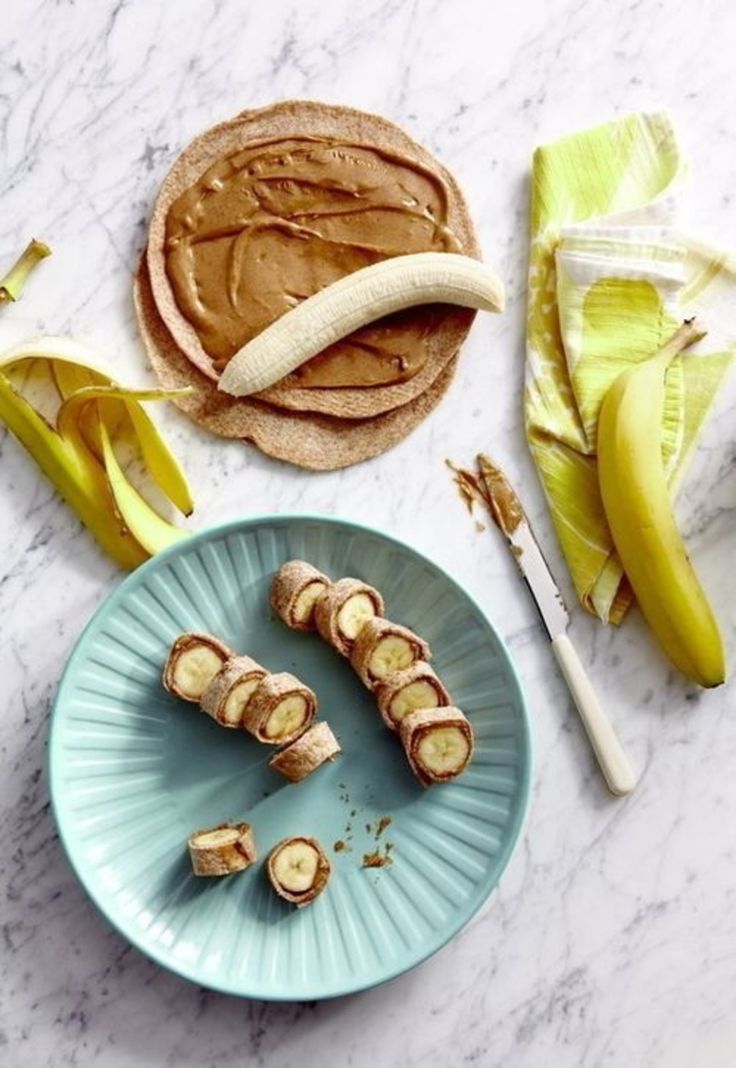 When you want to keep it simple, stick with soft, spreadable low-salt foods like mascarpone cheese, labneh, ricotta cheese, and yogurt—which taste extra creamy with a small dollop of smooth peanut butter whisked in for flavor.
When you want to keep it simple, stick with soft, spreadable low-salt foods like mascarpone cheese, labneh, ricotta cheese, and yogurt—which taste extra creamy with a small dollop of smooth peanut butter whisked in for flavor.
Reviewed by
J. Truppi, MSN, CNS
V. Kalami, MNSP, RD
K. Grenawitzke, OTD, OTR/L, SCFES, IBCLC, CNT
S. Bajowala, MD, FAAAAI. (allergy section)
R. Ruiz, MD Board-Certified General Pediatrician and Pediatric Gastroenterologist
- Food Allergy Research & Education. Peanut allergy. Retrieved February 25, 2021
- Food Allergy Research & Education. Learning Early About Peanut Allergy (LEAP). Retrieved February 25, 2021
- Fleischer, D., Spergel, J., Assa’ad, A.H., Pongracic, J. (2012). Primary Prevention of Allergic Disease Through Nutritional Intervention. The Journal of Allergy and Clinical Immunology: In Practice, 1(1). Retrieved February 25, 2021
- Ros E.
 (2010). Health benefits of nut consumption. Nutrients, 2(7), 652–682. DOI:10.3390/nu2070652. Retrieved February 25, 2021
(2010). Health benefits of nut consumption. Nutrients, 2(7), 652–682. DOI:10.3390/nu2070652. Retrieved February 25, 2021 - University of Florida. (2004, Dec. 11). Peanuts Rival Fruit As Source of Health Antioxidants, UF Researchers Say. [Press release]. Retrieved February 25, 2021/efn_note] 5Malaguarnera L. (2019). Influence of Resveratrol on the Immune Response. Nutrients, 11(5), 946. DOI:10.3390/nu11050946. Retrieved March 10, 2021
- Breuss, J. M., Atanasov, A. G., & Uhrin, P. (2019). Resveratrol and Its Effects on the Vascular System. International journal of molecular sciences, 20(7), 1523. DOI:10.3390/ijms20071523. Retrieved March 10, 2021
- Beluska-Turkan, K., Korczak, R., Hartell, B., Moskal, K., Maukonen, J., et al. (2019). Nutritional Gaps and Supplementation in the First 1000 Days. Nutrients, 11(12), 2891. DOI:10.3390/nu11122891. Retrieved February 25, 2021
- Hilger, J., Goerig, T., Weber, P., Hoeft, B., Eggersdorfer, M., (2015). Micronutrient Intake in Healthy Toddlers: A Multinational Perspective.
 Nutrients, 7(8), 6938–6955. DOI:10.3390/nu7085316. Retrieved February 25, 2021
Nutrients, 7(8), 6938–6955. DOI:10.3390/nu7085316. Retrieved February 25, 2021 - Arya, S.S., Salve, A.R., Chauhan, S. (2016). Peanuts as functional food: a review. Journal of food science and technology, 53(1), 31–41. DOI:10.1007/s13197-015-2007-9. Retrieved February 25, 2021
- Attalla, K., De, S., Monga, M. (2014). Oxalate content of food: a tangled web. Urology, 84(3), 555–560. DOI:10.1016/j.urology.2014.03.053. Retrieved February 25, 2021
- Arya, S.S., Salve, A.R., Chauhan, S. (2016). Peanuts as functional food: a review. Journal of food science and technology, 53(1), 31–41. DOI:10.1007/s13197-015-2007-9. Retrieved February 25, 2021
- Sterling, S. (2020). Lectins in Peanuts and Other Foods. The Peanut Institute. Retrieved February 25, 2021
- Sterling, S. (2020). Lectins in Peanuts and Other Foods. The Peanut Institute. Retrieved February 25, 2021
- Arya, S. S., Salve, A. R., & Chauhan, S. (2016). Peanuts as functional food: a review. Journal of food science and technology, 53(1), 31–41.
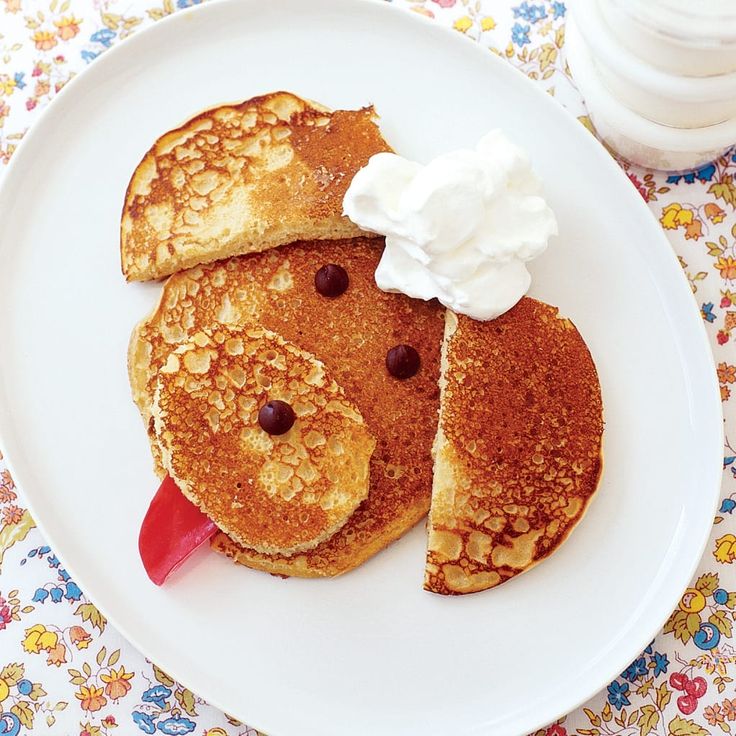 https://doi.org/10.1007/s13197-015-2007-9
https://doi.org/10.1007/s13197-015-2007-9 - Peanut Flour, defatted. USDA FoodData Central. Retrieved March 26, 2021.
- Gürses, M. (2006). Mycoflora and Aflatoxin Content of Hazelnuts, Walnuts, Peanuts, Almonds and Roasted Chickpeas (LEBLEBI) Sold in Turkey. International Journal of Food Properties, 9(3), 395-399. DOI:10.1080/10942910600596597. Retrieved March 10, 2021
- Arya, S. S., Salve, A. R., Chauhan, S. (2016). Peanuts as functional food: a review. Journal of food science and technology, 53(1), 31–41. DOI:10.1007/s13197-015-2007-9. Retrieved March 10, 2021
- HealthyChildren.org. (2019, September 30). Choking Prevention. Retrieved January 7, 2020
- Kusari, A., Han, A., Eichenfield, L. (2018). Recent advances in understanding and preventing peanut and tree nut hypersensitivity. F1000Research, 7, F1000 Faculty Rev-1716. DOI:10.12688/f1000research.14450.1. Retrieved February 25, 2021
- Food Allergy Research & Education. Peanut Allergy. Retrieved February 25, 2021
- Food Allergy Research & Education.
 Peanut Allergy. Retrieved February 25, 2021
Peanut Allergy. Retrieved February 25, 2021 - Anaphylaxis Campaign. (2017). Peanut Oil: The Facts. Retrieved February 25, 2021
- National Institute of Allergy & Infectious Disease. Guidelines for Clinicians and Patients for Diagnosis and Management of Food Allergy in the United States. Retrieved January 8, 2020
- National Institute of Allergy and Infectious Disease. (2017). Addendum Guidelines for the Prevention of Peanut Allergy in the United States. Retrieved February 25, 2021
- Pediatrics, Official Journal of the American Academy of Pediatrics. Timing of Solid Food Introduction and Risk of Obesity in Preschool-Aged Children. Susanna Y. Huh, Sheryl L. Rifas-Shiman, Elsie M. Taveras, Emily Oken and Matthew W. Gillman Pediatrics. March 2011, 127 (3) e544-e551.
- NIAID, Addendum Guidelines for the Prevention of Peanut Allergy in the United States, Retrieved March 25, 2021
- Altkorn R, Chen X, Milkovich S, et al. Fatal and non-fatal food injuries among children (aged 0-14 years).
Int J Pediatr Otorhinolaryngol. 2008;72(7):1041-1046. doi:10.1016/j.ijporl.2008.03.010
Fear of allergies - feed your baby peanut butter
1779
Bookmark
Professor Alan Boobis of Imperial College in London and his colleagues found that the inclusion in the diet peanut butter babies - which was previously considered one of the the most controversial products in baby food - capable of reduce the risk of developing allergic reactions in the future by up to 80%. Baby nutrition experts are rethinking their relation to this product. About the results of the study tells BBC News.
Allergy is considered one of the most common diseases modernity. For example, according to statistics, since 2008 in the USA the number of people affected by this disease has increased by four times. A similar picture is observed today in most Western world, as well as in some regions of Asia and Africa.
Previously, people introduced peanuts into the diet of young children very carefully - as a rule, not earlier than three years, since it was considered allergenic product.
The authors of the new study advise:
give children with allergies or severe diathesis peanut products at the age of 4-6 months under medical supervision
include foods in the diet of children with mild diathesis, containing peanuts from 6 months
children without allergies or diathesis use peanuts at any time time.
“We expect that the widespread implementation of these medical recommendations will prevent the development of peanut allergy in many susceptible children and ultimately reduce the prevalence peanut allergies in the United States,” said Dr. Anthony Fauci, director of the National Institute of Allergy and infectious diseases (USA).
Michael Walker, Fellow of the European Academy Allergology and Clinical Immunology, tells: “Recommendations are based on reliable medical research, held in the UK. Parents should consult your pediatrician if necessary, before trying to prevent peanut allergy in your child."
In the UK, new guidelines for child nutrition are still are under consideration, but Professor Bubis advises parents follow them now: "The former view, according to which delaying the introduction of allergenic foods reduces the risk of food allergies seems to be incorrect. Anyway, exclusion or untimely introduction of specific allergenic foods can only increase the risk of food allergies, including including peanuts,” he said.
Earlier portal Scientific Russia already wrote about a similar study in which 11 children “rescued” from allergies by eating peanuts at an early age.
allergens allergy peanut peanut butter
Information provided by the Information Agency "Scientific Russia". Mass media registration certificate: IA No. ФС77-62580, issued Federal Service for Supervision of Communications, Information Technology and Mass Communications on July 31, 2015.
Science Children
EG-5 accelerator: from dodging drought-resistant rice to stellar nucleosynthesis
18:30 / Physics
Scientists deduced the formula for individual screening of thrombosis 9000 9000 18:00 / Medicine
oxygen will help treat burns and injury to treat burns and injury
17:45 / Health, Medicine, New technologies0006
17:30 / Chemistry, Energy
Small natural fires or windblows support the biodiversity of forest landscapes
16:30 / Biology
Inside virtual reality. How the effect of presence works
16:00 / Illustrative example, New technologies, Expert talk
Scientists have found out how HIV can contribute to the development of lymphomas
15:30 / Biology, Medicine
"Pain neurons" directly protect the intestines from damage
15:00 / Biology
Scientists have discovered traces of the Tunguska phenomenon at the bottom of lakes
14:30 / Biology, Ecology
A well-known nuclear scientist, academician of the Russian Academy of Sciences Ashot Sarkisov has died 900 Sarkisov
14:30 / Science and society, Energy
In memory of the great scientist. Science in the global world. "Obvious - incredible" broadcast 05/10/2008
03/04/2019
In memory of the great scientist. Nanotechnologies. "Obvious - unbelievable" broadcast 08/3/2002
03/04/2019
Remembering Sergey Petrovich Kapitsa
02/14/2017
10 Healthiest Foods for Kids - Parents.ru
Pro Nutrition
, such as nuts, are safe for babies after 6 months if they are already familiar with grains, fruits, and vegetables. Nuts are a storehouse of trace elements. Peanuts, cashews, and almonds are high in protein, healthy fatty acids, vitamin E, and minerals such as manganese, potassium, and iron. At the age of one year, babies, of course, cannot eat such solid food.
A worthy alternative to nuts in this case is nut butter. Start introducing it into your baby's diet gradually: try adding a small amount to porridge or puree. You can buy pasta in large supermarkets or online, but you can also make your own. For this you will not need anything but nuts. Roast them in the oven. To do this, pour them in an even layer on a baking sheet and set at 180 degrees for 25 minutes. Next, remove the husk if you took peanuts. The final, and most important stage, is grinding nuts in a blender. At some point, they will begin to release oil - it is this that will turn the nut crumbs into a paste. This may take 6-15 minutes depending on the power of the blender. Honey can be added if desired. Ready pasta can be stored for a couple of weeks in a closed jar.
For this you will not need anything but nuts. Roast them in the oven. To do this, pour them in an even layer on a baking sheet and set at 180 degrees for 25 minutes. Next, remove the husk if you took peanuts. The final, and most important stage, is grinding nuts in a blender. At some point, they will begin to release oil - it is this that will turn the nut crumbs into a paste. This may take 6-15 minutes depending on the power of the blender. Honey can be added if desired. Ready pasta can be stored for a couple of weeks in a closed jar.
2. Eggs
- Photo
- Getty Images/Westend61
This is almost the perfect meal for a baby. They are easily digestible and contain folic acid, iron and choline, protein, vitamins A, D and E. Soft boil an egg, puree the yolk and mix with breast milk or infant formula to a consistency that a baby can handle at his age.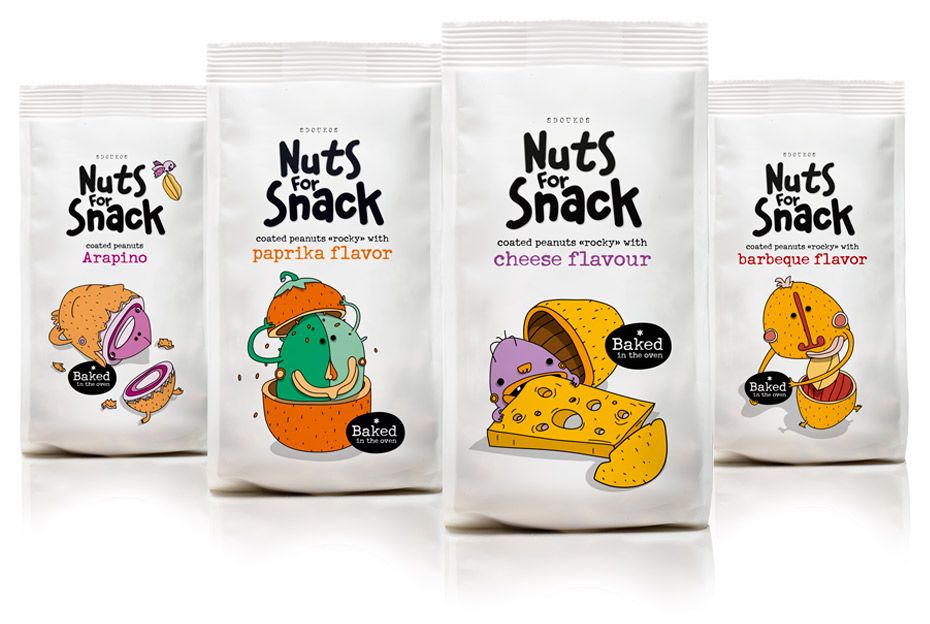 From 8-9 months, the baby can be given hard-boiled protein and an omelet, cut into small pieces.
From 8-9 months, the baby can be given hard-boiled protein and an omelet, cut into small pieces.
3. Oil
- Photo
- Getty Images/EyeEm
Don't be afraid of fats: their role in the development of the child's brain and nervous system has long been proven. Saturated fats and cholesterol should not be completely eliminated from the diet of children under 2 years of age. In addition, fats promote satiety, help you better absorb fat-soluble vitamins, and make food taste better. Therefore, some time after the child has tasted one-component puree, start adding a little butter to it. Choose organic to reduce your baby's exposure to pesticides. And a little later, do not forget to include other sources of fat in your child's diet: avocados, olive oil, yogurt and cheese.
4. Beans and lentils
- Photo
- Vlad Gilcescu/Getty Images
These legumes are rich in protein, iron, folic acid, zinc and manganese.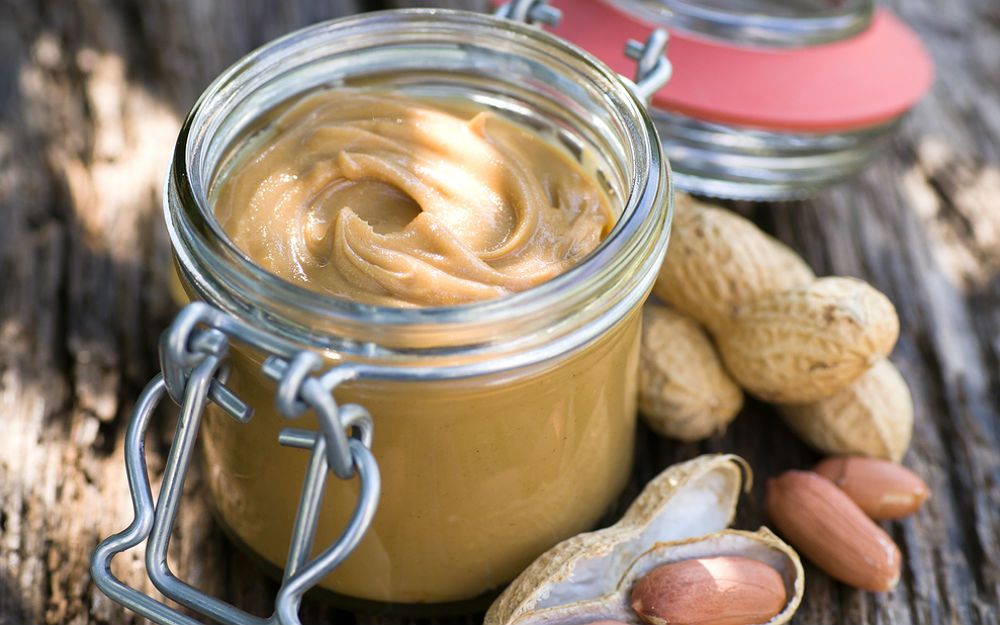 Soak beans for several hours or overnight in water. Strain and cook until very soft. Red lentils do not require soaking, as they cook very quickly. Puree cooked beans, or leave whole if baby is over a year old. Add them to soups, vegetable mixes, and stews once your little one is ready for more complex meals.
Soak beans for several hours or overnight in water. Strain and cook until very soft. Red lentils do not require soaking, as they cook very quickly. Puree cooked beans, or leave whole if baby is over a year old. Add them to soups, vegetable mixes, and stews once your little one is ready for more complex meals.
5. North sea fish
- Photo
- Getty Images/iStockphoto
Include salmon, tuna, herring and sardines in your diet: they are essential sources of polyunsaturated fatty acids, which play an important role in the normal functioning of the retina and development of the retina brain. Especially these acids are important for children during the first two years of life.
For very young fish, you can prepare fish as follows: simply bake it, remove the bones, skin and puree. Then mix with breast milk or infant vegetable formula. For older kids, just cut the fillet into small pieces or make salmon patties:
For older kids, just cut the fillet into small pieces or make salmon patties:
Mash the fillet with a fork. Add 2 tablespoons of breadcrumbs, egg and ground pepper, mix thoroughly. Shape into patties and roll in the remaining breadcrumbs. Fry over medium heat for 3-4 minutes on each side until golden brown.
6. Herbs and spices
- Photo
- Getty Images
After you have introduced your baby to solid foods, gradually start feeding him the meals that the whole family eats. To prevent such a transition from being abrupt, add various seasonings to baby food: this will help the child get used to the future diet. But do not overdo it, and, of course, avoid such hot spices as chili: the children's stomach is still too weak, and it may not be able to cope with such a load.
Here are a few combinations you can suggest to your little gourmet: applesauce with cinnamon, cauliflower with nutmeg, meat sauce with caraway or oregano, vegetables or chicken with thyme, avocado with cilantro, fish with parsley or lemon.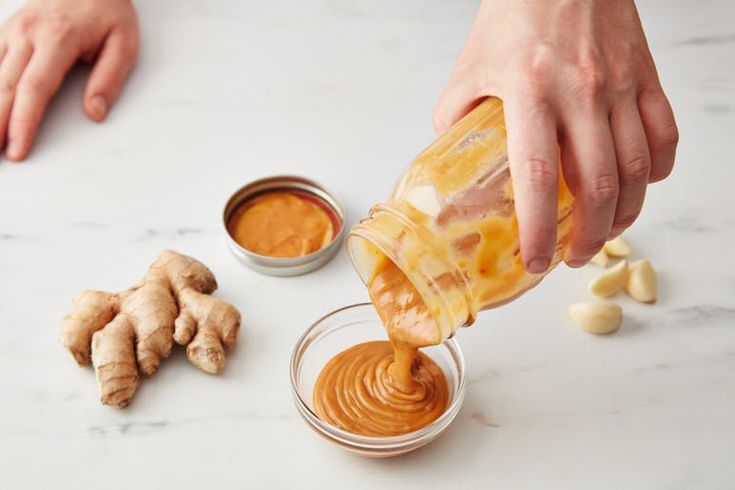
7. Tofu
- Photo
- Kevin Dyer/Getty Images
Doctors recommend introducing tofu into a baby's diet after a year of life, despite the fact that it is a potentially allergenic product. Tofu contains iron, zinc and a lot of protein. No wonder it forms the basis of the nutrition of vegetarians and vegans.
Tofu can be fried, baked, boiled and used in both main dishes and desserts. It is very soft and easy to chew, so your child will surely enjoy dishes with it.
8. Wheat bread and crackers
- Photo
- Alexander Spatari/Getty Images
Some parents restrict their children from eating foods containing gluten. They hope, therefore, to further reduce the risk of developing celiac disease. But, despite many studies showing the harm of gluten, there are also studies that suggest that its complete absence in the diet of children can even increase the risk of developing this autoimmune disease. Therefore, it is so useful for young children to give cereals, whole grain wheat bread or biscuits for breakfast.
But, despite many studies showing the harm of gluten, there are also studies that suggest that its complete absence in the diet of children can even increase the risk of developing this autoimmune disease. Therefore, it is so useful for young children to give cereals, whole grain wheat bread or biscuits for breakfast.
9. Plain yogurt
- Photo
- Getty Images
Choosing such a product when supermarket shelves are full of fermented milk products with all sorts of flavors seems contrary to common sense. But the fact is that flavored yoghurts can contain up to 3 teaspoons of sugar in one small jar. The child will easily get used to the sweet taste and will no longer want to eat ordinary yoghurts. Therefore, up to a year and a half, give them to your baby only without additives: at this age, children are less picky about food.





